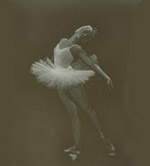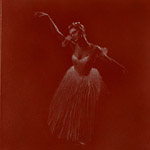Denis Yegelsky. Russian Ballet (painting, graphics, gummiarabic print).
 Booklet. Curator – Maria Savelieva. Denis Yegelsky’s Russian Ballet exhibition at Gallery D137 is a celebration of such stars of the Russian ballet as Natalia Makarova, Alla Sizova, Natalia Dudinskaya, Rudolf Nureyev and Konstantin Sergeyev. A professor of the New Academy of Fine Arts, Yegelsky addresses the photography of Mikhail Gershman, which captures the elegant plastics of famous ballet dancers in elegant images frozen forever in a moment in time. Mikhail Gershman was a leading Russian photographer from the 1930s to the 1970s. Undeservedly forgotten following his death, he was rediscovered in the early 1990s by Timur Novikov, who publicised his archive of photographs, retouching negatives bearing the personal autographs of internationally acclaimed stars. Gershman captured the personal idiosyncrasies in the faces of his famous compatriots, creating remarkable portraits of supple ballerinas and alluring actresses.
Booklet. Curator – Maria Savelieva. Denis Yegelsky’s Russian Ballet exhibition at Gallery D137 is a celebration of such stars of the Russian ballet as Natalia Makarova, Alla Sizova, Natalia Dudinskaya, Rudolf Nureyev and Konstantin Sergeyev. A professor of the New Academy of Fine Arts, Yegelsky addresses the photography of Mikhail Gershman, which captures the elegant plastics of famous ballet dancers in elegant images frozen forever in a moment in time. Mikhail Gershman was a leading Russian photographer from the 1930s to the 1970s. Undeservedly forgotten following his death, he was rediscovered in the early 1990s by Timur Novikov, who publicised his archive of photographs, retouching negatives bearing the personal autographs of internationally acclaimed stars. Gershman captured the personal idiosyncrasies in the faces of his famous compatriots, creating remarkable portraits of supple ballerinas and alluring actresses. Denis Yegelsky comes from a ballet family and studied under Konstantin Sergeyev at the Agrippina Vaganova Academy of Dance in St Petersburg. The ballet theme is a logical continuation of such works of the 1990s as the Ballet cycle (Mus. of History of Ballet). The poetic images and sharpened mastery of the more recent series of Russian Ballet works demonstrate the evolution of the artist’s creative ego. Yegelsky’s paintings of ethereal ballerinas create illusory images soaring through the mythical world of ballet, dominated by the proud silence of plastic art. Working in a monochrome style, the artist’s subtle chiaroscuro modelling draws the whittled figure and gracious pose of the ballerina out from the shadows. The flickering, diffuse light, terse composition, monochrome colour scheme, chilly tones and the domination of line help to create richly laconic images, appealing to the aesthetics of refined expressiveness and hovering on the verge of narcissism. Yegelsky’s artistic style is intensely graphic. His subtle grace and strong emphasis on line are derived from Botticelli and the ephemeral femininity of his artistic ideal. Yegelsky’s intimate works invoke the lyrical side of ballet. The mute sensuality of the dance does not so much exude passion as spout elegiac sorrow. The austere image, the scrupulous interpretation of the textures of the ballet costumes, the inner movement of the figure and its static pose in space evoke an allegory of the art of ballet and a fusion of the languages of music and the body. The dynamically developed rhythmic movements of the static figures convey the emotional tension of the dances of Odette, Odille, Giselle and Albrecht. These captivating, intimate works incorporate the motif of representativeness, expanding the borders of portraiture. The image – an allusion to the role of the artist – presents a fairytale hero caught in the grip of passion, alarm and sorrow. The Neo-Academicists and adherents of New Seriousness are naturally drawn to classical ballet, which traces its roots back to Ancient Greece. In St Petersburg, where Terpsichore, muse of music and dance, has reigned for several centuries, Denis Yegelsky’s one-man show cannot fail to capture the hearts and minds of all lovers of Russian art.
Denis Yegelsky comes from a ballet family and studied under Konstantin Sergeyev at the Agrippina Vaganova Academy of Dance in St Petersburg. The ballet theme is a logical continuation of such works of the 1990s as the Ballet cycle (Mus. of History of Ballet). The poetic images and sharpened mastery of the more recent series of Russian Ballet works demonstrate the evolution of the artist’s creative ego. Yegelsky’s paintings of ethereal ballerinas create illusory images soaring through the mythical world of ballet, dominated by the proud silence of plastic art. Working in a monochrome style, the artist’s subtle chiaroscuro modelling draws the whittled figure and gracious pose of the ballerina out from the shadows. The flickering, diffuse light, terse composition, monochrome colour scheme, chilly tones and the domination of line help to create richly laconic images, appealing to the aesthetics of refined expressiveness and hovering on the verge of narcissism. Yegelsky’s artistic style is intensely graphic. His subtle grace and strong emphasis on line are derived from Botticelli and the ephemeral femininity of his artistic ideal. Yegelsky’s intimate works invoke the lyrical side of ballet. The mute sensuality of the dance does not so much exude passion as spout elegiac sorrow. The austere image, the scrupulous interpretation of the textures of the ballet costumes, the inner movement of the figure and its static pose in space evoke an allegory of the art of ballet and a fusion of the languages of music and the body. The dynamically developed rhythmic movements of the static figures convey the emotional tension of the dances of Odette, Odille, Giselle and Albrecht. These captivating, intimate works incorporate the motif of representativeness, expanding the borders of portraiture. The image – an allusion to the role of the artist – presents a fairytale hero caught in the grip of passion, alarm and sorrow. The Neo-Academicists and adherents of New Seriousness are naturally drawn to classical ballet, which traces its roots back to Ancient Greece. In St Petersburg, where Terpsichore, muse of music and dance, has reigned for several centuries, Denis Yegelsky’s one-man show cannot fail to capture the hearts and minds of all lovers of Russian art.
Maria SAVELIEVA